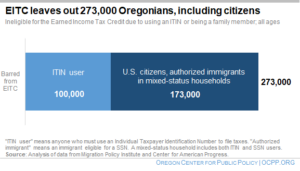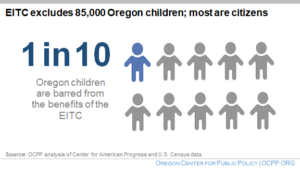A tax credit intended to lift up working families leaves out more than a quarter-million Oregonians, most of them U.S. citizens and authorized immigrants. Current law denies the benefits of the Earned Income Tax Credit (EITC) to the entire household if one member uses an Individual Taxpayer Identification Number (ITIN), as opposed to a Social Security Number (SSN).
In shutting out “mixed-status” households, this policy undermines the goal of the EITC: to boost the income of lower-paid households. The workers heading such families — disproportionately Latino and Asian-American families — drive key Oregon industries and pay millions in state and local taxes each year.
The EITC leaves out a quarter-million Oregonians, most in mixed-status families
Under federal law, workers who use an Individual Taxpayer Identification Number (ITIN) to file their taxes cannot qualify for the EITC — one of the most effective means of alleviating poverty.[1] Workers who use an ITIN include undocumented workers, student visa holders, certain survivors of domestic violence, and others.[2] Oregon uses federal eligibility rules for its own EITC.
The rule ends up denying the benefits of the EITC not only to workers with an ITIN, but also the people they live with. The federal EITC excludes the entire tax household if just one person uses an ITIN.[3] The exclusion of mixed-status households denies the EITC to the spouses and children of ITIN workers, many of whom are U.S. citizens and authorized immigrants.[4] In all, the rule denies the EITC to over a quarter-million Oregonians — 100,000 ITIN users and 173,000 U.S. citizens and authorized immigrants.[5] That amounts to 7 percent of Oregon’s population.

The exclusion harms one in 10 Oregon children
Oregon children are a casualty of the exclusionary policy. The rule denying the EITC to ITIN users deprives one in 10 Oregon children of the poverty-alleviating credit. The vast majority of excluded children are U.S. citizens. Specifically, 66,000 are citizens. Another 14,000 are authorized immigrants, and 6,000 are ITIN users.

Children living in mixed-status households in Oregon miss out on the benefits of the EITC. Decades of research shows that the income boost to households receiving the EITC improves the economic and social well-being of family members.[6] The EITC results in children doing better in school. It makes it more likely they will graduate from high school, go to college, and earn more as adults.[7]
U.S. immigration policy gives rise to mixed-status households
U.S. immigration policy has contributed to the rise of mixed-status households. Increasing militarization of the Mexico border has interrupted the historical seasonal migration pattern of workers from Mexico and Central America to the U.S. With border crossings restricted, the physical risks and costs of entry have increased. While militarization has done little to deter migrants from making an initial trip to the U.S. for work, it has made it more likely that workers will stay once they arrive and establish their families here.[8]
In addition, U.S. immigration policy has made it difficult to gain authorized status. For people born in Mexico — the origin country of Oregon’s largest undocumented population — wait times for permanent residency (“green card”) applications can be over 20 years. The delay will continue to grow, and for many who are newly in line, the wait is projected to last beyond their lifetime.[9]
The exclusion hampers the credit’s effectiveness
Denying the EITC to ITIN filers and their entire households undermines the effectiveness of the credit. The EITC recognizes that many jobs pay too little to support a family. The tax credit exists to lift up families getting by on low wages, improving the long-term well-being of families and entire communities. Mixed-status families are the very kind of households the EITC seeks to help.
First, the EITC aims to help working households. Immigrants in Oregon typically work. In fact, they are more likely to work than U.S.-born Oregonians.[10]
Second, the EITC seeks to help lower-paid workers. Immigrants in Oregon tend to work in lower-paying jobs. Many of Oregon’s immigrants — 40 percent — work in many of the state’s lower-wage occupations, such as service, production, and transportation jobs. By contrast, just 29 percent of Oregon’s U.S.-born workers labor in those occupations.[11] Incomes among those who are undocumented, in particular, are often low, with nearly 60 percent having income below 200 percent of the federal poverty level.[12]
Despite being paid little, immigrants are critical to Oregon’s economy, as they power key industries. For instance, while immigrants make up 13.3 percent of Oregon’s overall workforce, they comprise over 30 percent of workers in Oregon’s agriculture and forestry industries.[13]
Latino and Asian-American families bear the brunt
Families with Latino and Asian-American immigrants are more likely to be excluded from Oregon’s EITC than families made up of other racial and ethnic groups. Latinos are by far the largest group of Oregonians that must use an ITIN, followed by Asian-Americans.[14] A policy that treats Latino and Asian-American families differently divides Oregonians and ultimately limits the state’s economic and social potential.
Excluded Oregonians pay millions in state and local taxes
Oregonians excluded from the EITC contribute to the common good in many ways, including through the taxes they pay. Many U.S. citizens and authorized immigrants in mixed-status households excluded from the EITC pay taxes. Likewise, Oregon ITIN filers also pay millions in state and local taxes each year. Specifically, they pay a total of $81 million in property taxes, state income taxes, and sales and excise taxes.[15] This does not include the federal income or payroll taxes they also pay.
Conclusion
Excluding ITIN users and their families from the benefits of the EITC harms over a quarter-million Oregonians in working households. It deprives children the benefit of a tax credit proven to bolster academic success and overall well-being. It impacts far more Latino and Asian-Americans than other racial and ethnic groups. It makes life harder for low-wage workers playing vital roles in Oregon’s economy, even as they contribute to building the state through the taxes they pay. In short, denying the EITC to ITIN users undermines the goal of the tax credit.
[1] Economic Security Programs Reduce Overall Poverty, Racial and Ethnic Inequities, Center on Budget and Policy Priorities, January 28, 2021.
[2] ITIN filers include undocumented workers, student visa holders, some spouses and children of people with employment visas, and some survivors of domestic violence. See “Facts about the Individual Taxpayer Identification Number,” National Immigration Law Center.
[3] “Tax household” means the group of people included in a single tax return. The term “ITIN user” in this report refers to a person who must use an ITIN to file a tax return — people who have requested and been assigned an ITIN by the IRS and people who do not yet have an ITIN but would need to obtain one to file a tax return.
[4]” Mixed-status household” in this report refers to a tax household that includes people with an SSN and people with an ITIN. “Authorized immigrant” in this report refers to a person with lawful permanent or temporary residency who is eligible to obtain an SSN.
[5] OCPP analysis of data on the Oregon undocumented population from the Migration Policy Institute (MPI) and data on family members of unauthorized immigrants from Center for American Progress (CAP). The MPI data is available here; and CAP data is available here.
[6] The extensive research showing enduring benefits of the EITC for adults and children is summarized in EITC and Child Tax Credit Promote Work, Reduce Poverty, and Support Children’s Development, Center on Budget and Policy Priorities, October 1, 2015.
[7] Ibid.
[8] Douglas S. Massey, The Counterproductive Consequences of Border Enforcement, The Cato Journal, Fall 2017.
[9] “Immigration Wait Times from Quotas Have Doubled: Green Card Backlogs are Long, Growing, and Inequitable,” CATO Institute, June 18, 2019.
[10] Sixty-eight percent of working-age immigrants in Oregon are in the labor force, while less than 62 percent of working-age U.S.-born Oregonians are in the labor force. OCPP analysis of Migration Policy Institute data for 2018.
[11] Data from Migration Policy Institute, available here.
[12] Fifty-eight percent of undocumented Oregonians have income below 200 percent of the federal poverty level (estimate by Migration Policy Institute (MPI) for 2018), while 27 percent of U.S.-born Oregonians have income below that level (estimate by MPI for 2019). OCPP analysis of Migration Policy Institute data.
[13] Immigrants make up 31 percent of the workforce in Oregon’s agriculture, forestry, fishing and hunting, and mining industries combined. Migration Policy Institute, data available here The fishing, hunting and mining categories together make up 0.6 percent of all Oregon employment and are not listed in narrative.
[14] Seventy-eight percent of undocumented Oregonians were born in Mexico, Central, or South America. The next largest group is Asian-Americans, at 12 percent of Oregon’s undocumented population. “Unauthorized Immigrant Population: Oregon”, Migration Policy Institute.
[15] Undocumented Workers Pay Millions in Oregon Taxes and Would Pay Millions More under Immigration Reform, OCPP, April 17, 2017.







